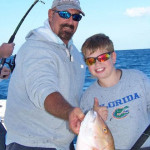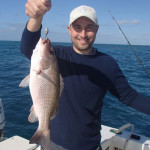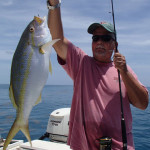November starts the cooling of the Keys waters in earnest. This cooling really gets things hopping in the offshore arena. The schools of bait fish are blown offshore with the passing of the cool fronts (a little early to call them cold fronts) and as they travel over the reef line there are a multitude of fish species that take advantage of the bounty. The most popular of these is the beginning of the winter sailfish run. The next most popular game fish is most likely the king mackerel. Hard to find anyone who doesn’t appreciate the speed and power of a mackerel’s first run although their popularity as a food fish is arguable.
My favorite target this time of year is neither of these. I prefer to spend my time on the quest for what is arguably the tastiest offshore species the Keys have to offer. The black fin tuna are by far my favorite treat and they are targetable with a variety of methods.
Trolling offshore in the neighborhood of three hundred feet of water takes a lot of fish this time of the year. Whether you prefer to troll small dart style artificial or plastic worms or you are a natural bait fan who favors the rigged ballyhoo you are sure to have success with any that you remember to keep way behind the boat in the spread. Two hundred feet behind the boat is not at all too far. Just remember that if the trolling grounds get crowded there is a good chance of getting your lines cut by another boat that cuts too close behind you.
There are those who prefer drifting or slow trolling with or without a kite. Live bait, ballyhoo or pilchards are the most popular baits for Keys anglers. The chance of finding a greater variety of fish exists if you cover a variety of depths working the water from just outside of the reef line to about three hundred feet. The rigging is the same for sailfish, dolphin and tuna. Fluorocarbon leaders around fifty pounds or less and at least six feet or longer are preferred.
All of these methods of targeting black fins are great and require very little physical exertion on the part of the angler until there is a hookup. Of course, my favorite method supplies my fishing ADD addicted self with something to do. Deep jigging is my method of choice. The tuna tend to go deep during the middle of the day and they will hang around structure if there is any to be had. In the upper keys there are several areas with seamounts or humps that hold tuna during midday. The waters from Islamorada to Marathon have humps that start in about eight hundred feet of water and reach up to almost four hundred feet. The Lower Keys is without these great structures but fortunately we have several wrecks that do a passable job of holding fish in waters from about one hundred fifty feet all of the way out to over four hundred.
The speed jig is the best method of reaching these depths and covering the entire water column to find the depths that the fish are holding. Over the last ten or so years the art of speed jigging has really become popular in the states. The speed jig is the heart of the art so to speak. These aero dynamic slabs of hologram embossed metal are designed to drop quickly to the bottom then be jigged back with a variety of actions to impart the ever popular wounded minnow effect. Game fish have a hard time ignoring the stop and start flutter of a well worked jig. The jigging specialty rod has come into its own in the last few years. These skinny rods are stronger than they look at first glance. The light weight noodle looking sticks have breaking strengths that exceed most of the heavy trolling sticks with big gold reels found on most offshore boats.
I like to mix and match my gear here and use Shimano Trevala Jigging Stick and a Penn Slammer spinning reel. The relatively recent advent of the instant anti reverse reels allow for instant hookup in the strike. I have always preferred spinning gear to conventional tackle just because it is what I was brought up on, but there are a lot of great anglers who like conventional tackle for jigging. The last part of the system that makes jigging so effective is the Spectra fiber line such as Berkley Big Game or Power Pro. These super small diameter lines also offer zero stretch characteristics allowing for maximum hook penetration on the strike. When speed jigging I prefer a long (about 12 to 15 feet) relatively heavy fluorocarbon leader in the area of sixty pound line.
I like to start a drift over the wreck by dropping my jig all of the way to the bottom then working the jig all of the way to the surface until I find the approximate depth that the fish are striking. Once you determine a depth to work you can drop the jig back to the bottom without bringing it all of the way to the surface.
This kind of fishing offers a real workout for the angler and you can over exert in short order. Pace yourself and remember to hydrate. This time of year, especially when the air starts to cool, it is easy to forget to keep the liquids flowing and working up a sweat while jigging is easy to do. If all goes according to plan you will have to dig out some of your favorite tuna tataki recipes and enjoy one of the great treats that the fall has to offer.




